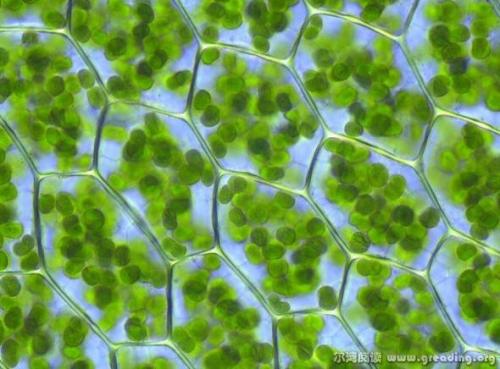In green plants, RNA synthesis takes place is a second organelle, the chloroplast, which is the site of all photosynthetic reactions. Each chloroplast has an outer membrane that separates the chloroplast from the cytoplasm and an inner membrane that surrounds a compartment called the stroma. Chloroplast DNA and the chloroplast protein synthetic machinery are present in the stroma.
The stroma also contains flat membranous sacs called thylakoids, which appear to be surrounded by a single continuous membrane that is the site of light-dependent photosynthetic reactions. The Chloroplast is believed to have originated as a cyanobacterial cell that somehow entered a eukaryotic cell. Because the cyanobacterial chromosome codes for more than 3000 different polypeptides and chloroplast DNA codes for only about 75 polypeptides, most protein coding genes were either transferred to nuclear chromosomes or lost during evolution. This transfer or loss probably took place very early in plant evolution because chloroplasts of evolutionarily distant green plants have similar gene content and organization. All chloroplasts arise from pre-existing chloroplasts.
Chloroplast DNA is a circular double-stranded negative supercoil that is about 120 to 180 kbp long. A typical chloroplast many contain as few as ten or as many as a few hundred DNA copies that are organized into nucleoids associated with the inner chloroplast membrane. In addition to their protein coding genes, Chloroplast DNA from higher plants also contain four rRNA genes and 30 tRNA genes. No RNA is imported into chloroplast. Chloroplast genes of higher green plants often contain a single groupⅠor groupⅡintron.
Chloroplast DNA codes for an RNA polymerase that resembles the bacterial core RNA polymerase (α2ββ’)and contains homologous subunits to α, β, and β’. The plastid encoded RNA polymerase(PEP)requires the assistance of a transcription factor that resembles σ70 to transcribe chloroplast genes. The chloroplast has at least six different σ factors are encoded by nuclear genes, synthesized in the cytoplasm, and then imported into the chloroplast. The chloroplast holoenzyme acts on chloroplast genes with promotes that have a -10 box and a -35 box. At least one chloroplast σ factor recognizes E.coli promoters.
Chloroplast also have two additional RNA polymerases that are encoded by nuclear genes.The first of these, nuclear encoded plastid RNA polymerase, resembles T7 phage RNA polymerase.
The second, plastid RNA polymerase(NEP-2)has not yet been characterized . Further work is required to determine how the three different RNA polymerase work together in chloroplast gene transcription.








